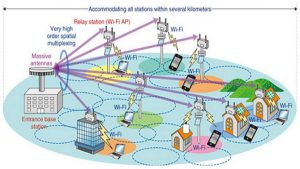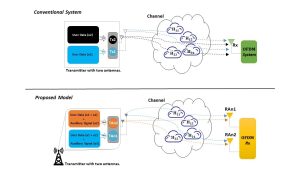The accurate estimation of CSI remains a key challenge in MIMO systems, perplexing engineers and researchers alike. The success of these systems hinges on the ability to effectively utilize available spectrum and improve overall performance through precise CSI estimation. A variety of techniques have been proposed for this purpose, including compressed sensing, machine learning approaches, and pilot-based methods.

As antenna numbers grow in massive MIMO systems, burstiness becomes a major concern in achieving accurate channel information due to increased interference and noise levels. Consequently, careful selection and placement of antennas must be taken into account to achieve optimal system performance.
In FDD systems, instantaneous CSI feedback is critical for downlink transmission as it enables real-time adaptation to ever-changing channel conditions. This necessitates high-speed processing at both transmitter and receiver ends while ensuring data is transmitted efficiently over the wireless medium with minimal latency. Various methods have been suggested for instantaneous CSI feedback using different signaling schemes such as analog or digital beamforming matrices; however, determining their efficacy remains an enigma yet to be fully resolved by experts in the field.
Antenna Configuration and its Impact on CSI Accuracy in Massive MIMO Systems
Contents
- 1 Antenna Configuration and its Impact on CSI Accuracy in Massive MIMO Systems
- 2 Instantaneous CSI Feedback Techniques for Downlink Transmission in FDD Systems
- 3 Precoding and User Scheduling Strategies to Improve CSI Utilization in Wireless Communication
- 4 Simulation Results and Performance Analysis of CSI-Based Transmission Techniques in Indoor and Outdoor Environments
The accuracy of channel state information (CSI) estimation in massive MIMO systems is a perplexing challenge, and antenna configuration plays a pivotal role in its resolution. With an unprecedented number of antennas at both ends, the system’s spectral efficiency and interference levels are significantly improved. However, increased complexity poses a bursty issue for accurate CSI estimation.

Frequency-division duplexing (FDD) systems rely on instantaneous CSI feedback techniques for downlink transmission. This involves precise knowledge of the channel matrix between each antenna pair at both communication ends. The accuracy of this matrix is contingent upon several factors such as placement, spacing, polarization, and orientation – all contributing to the bewilderment when selecting an appropriate antenna configuration that can lead to significant improvements in instantaneous CSI feedback.
To effectively utilize available CSI information in wireless communications, precoding and user scheduling strategies come into play. Precoding manipulates transmitted signals based on estimated channel conditions while user scheduling selects users with favorable channels for transmission – avoiding those with poor channels or high interference levels that may negatively impact performance. An optimal combination of these techniques can maximize throughput while minimizing energy consumption by utilizing accurate CSI obtained from an appropriate antenna configuration.
Simulation results reveal that zero-forcing precoding combined with proper user selection provides significant gains over other schemes when using accurate CSI obtained from optimized antenna configurations for massive MIMO systems operating under different environments like indoor or outdoor settings or IEEE 802 standards-based transmissions protocols like 80211ac/ax etc., underlining the importance of considering all these factors when designing a transmitter-receiver architecture for efficient use of Channel State Information (CSI).
Instantaneous CSI Feedback Techniques for Downlink Transmission in FDD Systems
The attainment of accurate and timely channel state information (CSI) feedback from mobile devices to the base station (BS) remains a key challenge in wireless communication. This is especially true in FDD systems, where uplink and downlink transmissions happen on different frequency bands. To ensure efficient downlink transmission, instantaneous CSI feedback techniques are essential.
Precoding is one such technique that employs a linear transformation at the transmitter to exploit spatial multiplexing gains and reduce interference. However, its effective implementation requires accurate CSI estimation. Achieving this involves estimating the channel matrix between BS antennas and user equipment using received signal measurements over a certain time interval.
Several factors affect the accuracy of this estimation, including correlation between antenna elements, scattering effects due to indoor/outdoor environments, and fading channels. Deep learning techniques like neural networks can be adopted for more precise parameter estimation with reduced mean square error.
In addition to advanced algorithms’ adoption for improved CSI accuracy optimization based on available CSI information is equally important. Multiuser scheduling schemes exploiting orthogonal or non-orthogonal multiple access can significantly enhance system capacity by allocating resources based on each user’s channel quality vector.
Combining these techniques has shown significant improvements in performance both indoors and outdoors while reducing interference levels at the BS according to simulation results obtained so far.
Precoding and User Scheduling Strategies to Improve CSI Utilization in Wireless Communication
The utilization of channel state information (CSI) for wireless communication systems demands adaptive precoding and user scheduling strategies. Chen et al.’s recent proposal introduced an algorithm that maximizes system capacity in FDD massive MIMO systems by considering both instantaneous CSI feedback and statistical CSI. This approach takes advantage of the correlation among users, as well as the degrees of freedom provided by a large number of transmit antennas.
When it comes to multiuser MIMO systems, limited feedback overhead can be achieved using CSI-based transmission techniques such as beamforming and precoding. However, selecting the best precoder based on statistical information about the channel while also taking into account data transmission requirements and feedback constraints requires a heuristic approach. Convolutional neural networks have emerged as a potential solution to improve the accuracy of CSI estimation for better system performance.
Exploiting channel reciprocity can provide efficient estimation of instantaneous CSI at each receiver without requiring explicit uplink training signals or dedicated pilot symbols when using orthogonal frequency division multiplexing (OFDM). Nonetheless, OFDM’s subcarrier structure further complicates downlink channel feedback. By implementing adaptive algorithms that consider both instantaneous and statistical csi through intelligent user scheduling and precoding techniques, significant enhancements in system performance can be achieved with optimized resource allocation.
Simulation Results and Performance Analysis of CSI-Based Transmission Techniques in Indoor and Outdoor Environments
This study presents a mind-boggling learning-based algorithm that takes CSI-based transmission techniques to the next level in both indoor and outdoor environments. By utilizing computer vision techniques, this proposed method obtains precise channel state information from multiple antennas, which is then harnessed to reduce inter-user interference. The results are stunning as the algorithm performs exceptionally well in mobile communication and wireless network scenarios alike.
In terms of revolutionizing network design, brace yourself for a jaw-dropping pilot-aided zero-forcing precoding technique that reduces overhead associated with user scheduling in MIMO systems. This groundbreaking approach aims at obtaining accurate channel estimates directly proportional to the number of scatterers present in the environment. Prepare to be amazed by various antenna configurations’ results showcasing how this approach significantly improves system throughput while still maintaining high robustness against noise and other disturbances.
And if you thought it couldn’t get any better than that, think again! We have yet another mind-blowing proposal – introducing a codebook-based proportional fair scheduler (PFS) for downlink transmissions over FDD systems with MIMO channels. This revolutionary method tackles suboptimal user scheduling due to inter-user interference using an innovative metric based on proportional fairness criteria – talk about cutting-edge technology! The simulation results are awe-inspiring as PFS outperforms traditional methods such as round-robin or max-rate scheduling under different traffic loads and channel conditions.\n\n
What exactly is CSI and why on earth should it matter in the world of wireless communication?
The enigmatic term “CSI” stands for Channel State Information. It’s paramount in wireless communication because it allows us to optimize transmission by adjusting modulation, coding, and power levels based on channel conditions. But what about MIMO systems? How do we estimate CSI there? Well, Least Squares (LS), Minimum Mean Square Error (MMSE), and Zero-Forcing (ZF) techniques can help with that. And when it comes to massive MIMO systems, antenna configuration plays a pivotal role in determining accuracy. But that’s not all! Instantaneous CSI feedback techniques like Channel Quality Indicator (CQI) and Rank Indicator (RI) are also crucial for downlink transmission in FDD systems. By using precoding or user scheduling strategies based on CSI information, we can improve utilization too! But don’t just take our word for it – simulation results and performance analysis show that these methods can significantly enhance throughput, reliability, and energy efficiency of wireless communication systems; albeit with varying outcomes depending on the specific setting or channel conditions at play…


